Oswald the Lucky Rabbit had a number of makeovers over the span of 80 years. From a black and white "rubber hose" style character to an anthropomorphic rabbit. The cartoon icon never stayed the same for long. The majority of these changes were done in the first decade and last decade that Universal owned the character.

The Disney company made a few further changes once regaining the rights to Oswald in 2006. What the company focused on was getting audiences interested in the character once more. The company had long abandoned having mascot characters in animated shorts at the front of their feature films as well as on television. They had to find other formats in which to get Oswald to the fans. For fans in Europe that still had Disney comics in print the studio published a one-shot Christmas story featuring the rabbit. It would be a teaser of the bigger project planned in store for Oswald. Not to be outdone
the Japanese had a short holiday cartoon online courtesy of the Tokyo Disney Parks. These things were minor appearances in comparison to what the Disney Company had in store. After several years it was time to take the wraps off of Epic Mickey. The game was a love letter to the Disney Parks and was created as the launchpad for Oswald. Director Warren Spector filled the game with tremendous insight into the characters and classic universe that created the Disney empire.
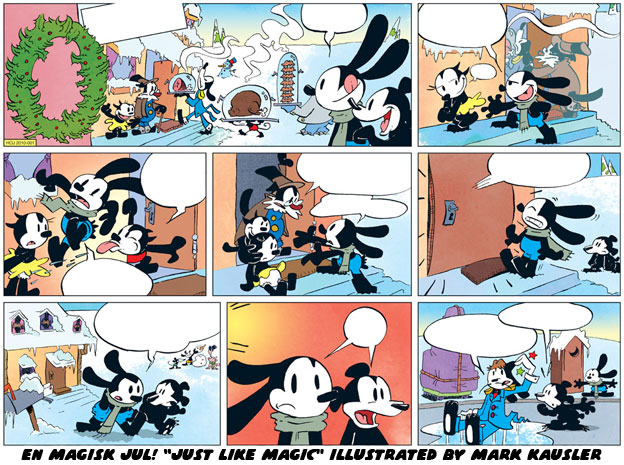
The game was in 3D but had traditionally animated 2D cut scenes. This gave audiences a good look at Oswald and his love Ortensia using the latest animation techniques. The characters had a timeless quality and made the transition to the modern world fairly well. In order to help get more people behind the game Disney released a graphic novel through the iTunes Store and then a series of short stories known as the Tales of the Wasteland. Seasoned comic book writer Peter David wrote the story and prequel to Epic Mickey. The difficult part for Disney was that it didn't have a team of comic artists working in the US at the time. The studio had closed down its comic strip wing decades earlier and had licensed out the comic rights to Gladstone / Gemstone in the '90s. Unfortunately the studio pulled the license so there hadn't been a new comic book created and written by Disney artists in years. However in Italy the artists and writers of Topolino magazine hadn't stopped in over 60 years. In Italy the Disney company had a great relationship with the Milano Design College. They offered a program that was called the Disney Academy. Artists were trained in the proper ways to illustrate the characters from the Disney Library, these included some very rare figures some of which appeared only once in animated form more than 80 years ago! The comic artists working on Topolino were just some of the many illustrators produced by the Academy and featured in the Epic Mickey comics. There were also artists responsible for creating the character art that would appear in advertising and logos used in the parks, hotels and cruise lines.
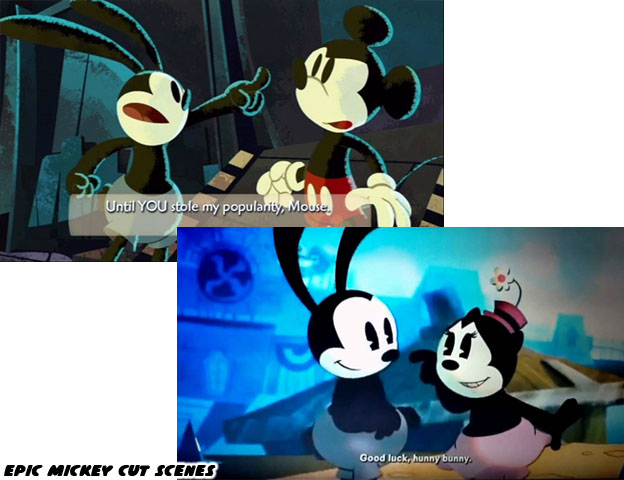
Four different artists were put on the Epic Mickey comics including Claudio Sciarrone, Fabrizio Petrossi, Fabio Celoni and Paolo Mottura. Each artist had their own style but tried to stay on model when working with Oswald. He was the rarest of the rare characters after all. Topolino magazine was published weekly so the artists had to be very productive. The editors would allow artists to spend more time inking and coloring some of the bigger story arcs, they would introduce these special stories with some fanfare, and even a trailer or toy announcement. For the most part the art was usually very simple and colors flat on the majority of the stories. The Epic Mickey graphic novel had a lot more time put into the art and it showed. Visually it was a stunning collection of comic and cartoon panels. The artists had enough leeway to shout-out some of their biggest influences such as the legendary Frank Frazetta.
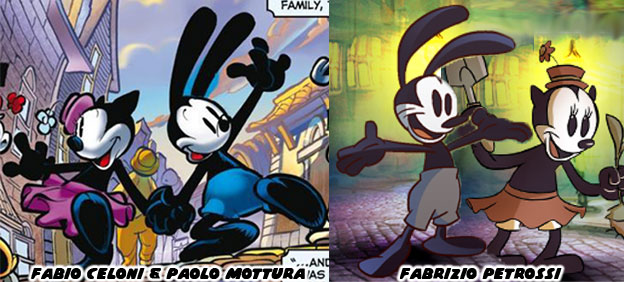
The art suffered slightly for the Tales of the Wasteland issues, it was on par to the weekly Topolino issues. Those comics featured characters rendered with less detail. Yet that was the price that the Disney company was willing to pay in order to make sure that the e-comics were ready in time for the launch of Epic Mickey. Meanwhile the developers in the US were trying to figure out a way to frame Oswald that would endear him to audiences. They did this by creating an entire mythos around Oswald for Epic Mickey. He was one of the "forgotten" characters created by Yen Sid the Sorcerer. Mickey Mouse had accidentally destroyed a portion of a concept theme park when he spilled ink and thinner onto a map. The classic cartoon characters that called that place home were devastated. Oswald helped keep those characters together and turned himself into a hero in the process.
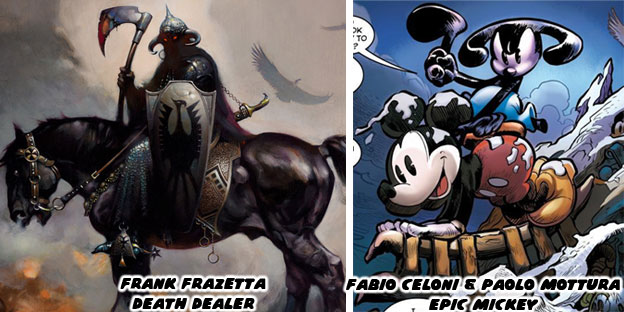
In the canon of Epic Mickey Oswald turned the Wasteland into an homage to Walt and himself. It was like an alternate universe where Mickey had never existed. The designers working at Disney Interactive and Junction Point studio had created multiple interpretations of the character. Some for the level details, cut scenes and even environmental art. The most important thing that the company did was recreate the classic Ub Iwerks character in 3D. Oswald had been out of the loop for more than half a century yet rather than try to make a contemporary version of the rabbit, or try to update his designs in order to match the current Mickey Mouse the artists focused on all the classic elements. Oswald retained his round eyes, shorts and squared-off proportions from 1927-1928. Very little was done to him in the Epic Mickey sequel. Players could dress the rabbit in different costumes but he essentially remained the same as he was all those years earlier. He had a strong personality, was mischievous but brave at the same time. He worked alongside Mickey Mouse to help save the Wasteland and see Walt Disney's vision become whole.
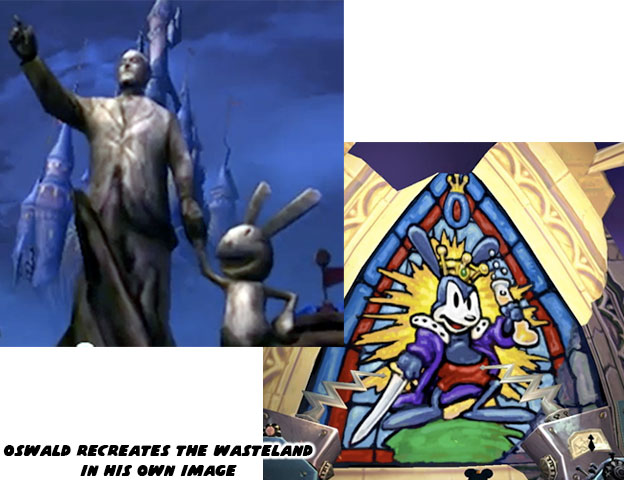
It was great to see Oswald's design come full circle. He changed tremendously after he was introduced to audiences. His anthropomorphic makeover may have been a response to Warner Bros introduction of Bugs Bunny. Several of Walter Lantz' animators, including Tex Avery, also worked for Warner Bros and helped create the library of characters for the studio. Whatever the reason for Oswald's radical makeover he predated the appearance of Bre'r Rabbit from Song of the South (1946) and even Thumper from Bambi (1942). The one person who didn't try and track all the changes that Oswald went through was Walt Disney. After losing Oswald to Universal he never spoke about the character again publicly or even privately. He never even mentioned Oswald to his daughters while they were growing up. When Bob Iger took over as CEO of Disney from Michael Eisner he was interested in the character and wanted to return the Lucky Rabbit to the Disney library. He saw an opportunity when NBC / Universal were in talks to get sports commentator Al Michaels from ABC / ESPN which Disney owned. When the news hit the family that the company had gotten the rights back to Oswald they didn't realize right away that it was a lost character created by Walt himself. Thankfully Iger and the art teams, in animation and product design, working at the company knew to restore the look and feel of the classic Oswald and not try to modernize him. Of course part of that credit also goes to Warren Spector and his team at Junction Point and Disney Interactive studios. They were able to take an 80-year-old celluloid rabbit and create a lifelike 3D version for audiences to follow.
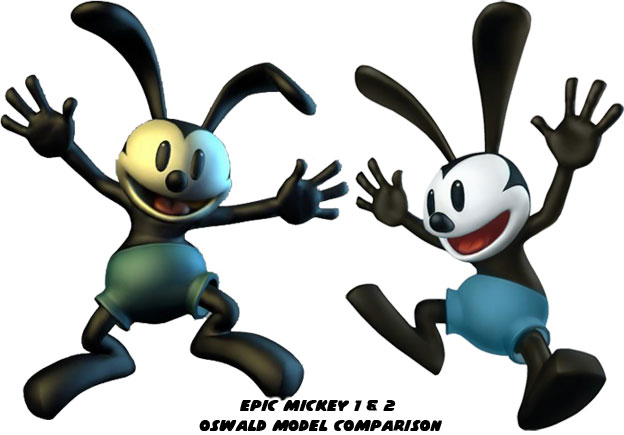
Walt did not live long enough to see his character returned but he would have undoubtedly loved it. Oswald would be embraced by an entirely new generation and no cartoon mascot was ever luckier.
If you would like to sponsor me
please visit my Patreon page and consider donating each month, even as little as $1 would help make better blogs and even podcasts! 







No comments:
Post a Comment